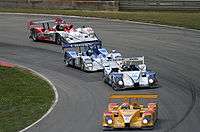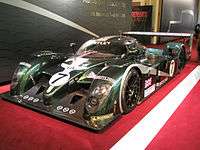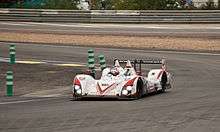Le Mans Prototype
A Le Mans Prototype (LMP) is the type of sports prototype race car used in the 24 Hours of Le Mans, FIA World Endurance Championship, WeatherTech SportsCar Championship, European Le Mans Series and Asian Le Mans Series. Le Mans Prototypes were created by the Automobile Club de l'Ouest (ACO). The technical requirements for an LMP include bodywork covering all mechanical elements of the car.


While not as fast as open-wheel Formula One cars, LMPs are the fastest closed-wheel racing cars used in circuit racing. Le Mans Prototypes are considered a class above production-based grand tourer cars, which compete alongside them in sports car racing.
Modern LMP designs include hybrid cars that use electric motors to assist acceleration.[1] The Le Mans Prototype LMP1 class will be replaced by Le Mans Hypercars in the FIA World Endurance Championship, and the 24 Hours of Le Mans from the 2021 season, but LMP1 cars will be eligible to be "grandfathered" for one final season, to compete alongside the new class for the 2021 season.[2]
Name variations
Le Mans Prototypes have used various names depending on the series in which they compete. The FIA's equivalent cars were referred to as Sports Racers (SR) or Sports Racing Prototypes (SRP). The American IMSA GT Championship termed their cars World Sports Cars' (WSC), while the short-lived United States Road Racing Championship used the classic Can-Am (CA) name for their prototypes. Since 2004, most series have switched to referring to these cars as Le Mans Prototypes. The American Le Mans Series, the successor to the IMSA GT Championship and the predecessor of the TUDOR United SportsCar Championship, officially referred to the cars simply as Prototypes (P1, P2, or PC). An LMP is commonly referred to as a Le Mans car in the media.[3][4]
History
The first use of what would become Le Mans Prototypes was at the 1992 24 Hours of Le Mans. In an attempt to increase the number of entrants beyond the small field of Group C competitors that the World Sportscar Championship had to offer, older Porsche 962s were allowed entry in Category 3. To further increase the size of the field, small open-cockpit race cars using production road car engines which were raced in small national championships, were allowed in Category 4.[5] Only three cars (a Debora-Alfa Romeo, a Ren-Car Peugeot and a WR-Peugeot) were entered, with all failing to run more than a few hours.
However at the end of 1992, the World Sportscar Championship as well as the All Japan Sports Prototype Championship collapsed, leaving the expensive Group C prototypes little competition outside Le Mans. With Group C being phased out, the ACO chose to allow production-based race cars to enter for the first time in many years, while at the same time creating the Le Mans Prototype (LMP) class. The cars continued to use the same formula as they had in 1992.
Later, ACO announced their intentions to completely replace the Group C cars with Le Mans Prototypes in 1994. Two classes were created, with LMP1s running large displacement custom-built engines that were usually turbocharged, and LMP2s using the smaller displacement production-based engines. Both classes were required to have open cockpits. However, LMP1 cars that year were just former Group C cars, still with closed cockpits (Toyota 94C-V, Courage C32, Kremer K8, Porsche 962 GTI, ALD C289 and Alpa LM). At the same time, the IMSA GT Championship announced the end of their closed cockpit GTP and Lights classes, deciding as well to replace them with a single open-cockpit class of World Sports Cars equivalent to LMP1.

This formula continued up to 1996, with many manufacturers embracing the LMP and WSC classes, including Ferrari, Porsche, and Mazda. In 1997, the first European series based around Le Mans Prototypes was launched, known as the "International Sports Racing Series". Using classes similar to LMP1/WSC and LMP2, these cars were known as "SR1" and "SR2" by the FIA. 1998 saw the creation of another series of Le Mans Prototypes, with the new United States Road Racing Championship (USRRC) attempting to break away from the IMSA GT Championship. To differ from IMSA'S WSC class, the USRRC named their open-cockpit prototypes "Can-Am" in an attempt to resurrect the sportscar championship of the 1970s. However the USRRC collapsed before the end of 1999, with the series becoming the Rolex Sports Car Series who chose to use the FIA's SR1 and SR2 formula instead.
1998 saw a great expansion for the ACO's LMP classes. Following the cancellation of the IMSA GT Championship at the end of 1998, the ACO allowed for the creation of the American Le Mans Series. This series used the same class structure as the 24 Hours of Le Mans, meaning it was the first championship to use the LMP name. At the same time, the ACO greatly altered their LMP classes. The smaller LMP2 class were briefly eliminated, while a new class of closed-cockpit prototypes were allowed in, known as "LMGTP" (Le Mans grand touring prototype). These cars were evolutions of production-based road cars that the ACO considered too advanced and too fast to fall under the GT class regulations, forcing the ACO to promote them to prototypes.

In 2000, changes were made to the LMP regulations, as the ACO once again split the open-cockpit LMP class. The two new classes became known as "LMP900" and "LMP675", with the numbers denoting the minimum weight requirements (in kilograms) for each class. The LMP900s were to be more powerful and faster in top speed, but also heavier and more cumbersome. The LMP675s were to be smaller and more nimble, yet lack the top speed of the larger class. Both classes were intended to be able to compete for overall wins. Audi, Chrysler, Cadillac, and Panoz opted to use the LMP900 formula, while MG were the only major manufacturer to attempt the LMP675 class. The LMGTP class also continued, with Bentley being the only manufacturer to build a closed-cockpit prototype after the regulation changes in 2000.
Outside Le Mans, the FIA's SR classes suffered from these rule changes. The SR2 class no longer aligned perfectly with the new LMP675 class, with the more powerful and durable racing engines that were allowed there. The SR1 and LMP900 classes also did not use the same rules, although engines were mostly similar. This meant that teams competing in the newly renamed FIA Sportscar Championship required modifications to their cars to be able to compete at Le Mans and in the new European Le Mans Series (ELMS), a second series split from the American Le Mans Series. With FIA Sportscar Championship teams unwilling to modify their cars to run in the ELMS, that series was canceled due to lack of participants. However the demand to race at Le Mans eventually forced the FIA Sportscar Championship itself to be canceled in 2003, with most competitors choosing to comply with the ACO's regulations instead of the FIA's. With the Rolex Sports Car Series also abandoning their SR classes at the end of 2003 for their own unique Daytona Prototypes, this meant that the ACO LMPs were the only open-cockpit prototypes left.

With the prototype classes now unified under the ACO's rules, the class structure was once again reorganized. The LMP675 class was considered a failure, due to the small engines lacking the reliability necessary to compete for overall wins, regardless of any advantage they had with cornering and weight. The LMGTP class was also considered redundant since the cars had only minor rule differences from LMP900s. Thus, the classes were changed to LMP1 and LMP2, with the top class once again being larger and more powerful. However the smaller LMP2 class was now intended solely for privateers, with major manufacturers encouraged to move to LMP1. This meant LMP2s were no longer meant to run for overall race wins. Since the LMGTP class was eliminated, both LMP1 and LMP2 were allowed to have either open- or closed-cockpit designs. These new rules also added increased safety requirements, including larger rollover hoops and aerodynamic plates attached to the rear of the cars in order to prevent prototypes from becoming airborne in accidents.
The LMP1 and LMP2 classes continue to be used at the 24 Hours of Le Mans and in the newer championships that were created by the ACO: the Le Mans Series in 2004 and the Japan Le Mans Challenge in 2006. In 2004, the ACO renamed LMP900 back to LMP1, and with this they limited the rear wing to 1.9m and reduced the fuel tank capacity from 90L to 80L. This was done in an effort to promote new hybrid LMP1 cars while putting more restrictions on the aging LMP900 cars like the Audi R8. New safety measures were also brought in, and prototypes were now required to have two rollover bars instead of one. The final year that LMP900 chassis were allowed to be entered was 2006.
In 2009, LMP2 restrictors were brought down from 45.5mm to 43.5mm.
From 2017, in order to limit the costs, FIA introduced a new set of regulations, which will be locked in through 2020, aiming a significant power increase, to the range of 150 horsepower (which is expected to lead to a four-second decrease in lap time at Le Mans). Gibson Technology is the exclusive engine supplier for LMP2, producing a four-litre normally-aspirated V8.[6]
Dallara, Onroak Automotive (Ligier), Oreca and the joint-venture Riley Tech/Multimatic were selected by FIA as the four exclusive chassis constructors for LMP2,[7] which must be closed-cockpit designs.
Technical regulations
Biofuels, specifically petrol with 10% ethanol and biodiesel (BTL), are allowed in both LMP1 and LMP2 categories. The main technical regulations for LMP class cars are:
LMP1
The fuel tank size and minimum weight for non-hybrid cars is subject to adjustment to reduce the difference in performance between hybrid and non-hybrid cars.
There are no limits on the number of cylinders for any type of engine.
Bodywork is required to cover all mechanical elements of the car, so that they cannot be visible when the car is viewed directly from the front, side, or top.
The LMP1 cars are generally the most powerful, with higher straight-line speeds.
.jpg)
| Hybrid | Non-hybrid | |
|---|---|---|
| Minimum weight | 878 kilograms (1,936 lb) | 833 kilograms (1,836 lb) |
| Maximum length | 4,650 millimetres (183 in) | |
| Minimum width | 1,800 millimetres (71 in) | |
| Maximum width | 1,900 millimetres (75 in) | |
| Engine displacement | no limit | max. 5.5 litres (340 in3) |
| Fuel tank size for petrol engines | 62.3 litres (16.5 US gal) | 75 litres (20 US gal) |
| for diesel engines | 50.1 litres (13.2 US gal) | |
| Maximum wheel diameter | 28 inches (710 mm) | |
| Maximum wheel width | 14 inches (360 mm) | |
LMP2
Until 2016, LMP2 allowed both open and closed-cockpit designs (closed cars must have a windscreen, a roof, and doors on each side), while only closed-cockpit design is allowed for LMP1 as it is much faster and safer. As of 2011, all cars must have fins on the rear bodywork to prevent them from rolling over in the air during crashes. Although a passenger seat is not used, cars must be designed to carry two people. The empty area of the cockpit is usually used to hold electronic devices and cooling equipment. Only production-based engines were allowed in LMP2 with diesel engines permitted from 2013 onward.
From 2017, in order to limit the costs, FIA introduced a new set of regulations, which will be locked in through 2020, aiming a significant power increase, to the range of 150 horsepower (which is expected to lead to a four-second decrease in lap time at Le Mans). Gibson Technology is the exclusive engine supplier, producing a 4.2-litre naturally-aspirated V8, producing about 600 bhp[9]
Dallara, Onroak Automotive (Ligier), Oreca and the joint-venture Riley Tech/Multimatic were selected by FIA as the four exclusive chassis constructors,[10] which must be closed-cockpit designs.
The Daytona Prototype International class (DPi) is based on the 2017 LMP2 rules, and features custom bodywork and engines by road car manufacturers.

.jpg)
| Minimum weight | 930 kilograms (2,050 lb) |
| Maximum length | 4,750 millimetres (187 in) |
| Overall width | 1,800 millimetres (71 in) (min) to 1,900 millimetres (75 in) (max) |
| Maximum Height |
1,050 millimetres (41 in) |
| Engine | 4.2 litres (260 in3) V8 naturally-aspirated petrol engine (homologated) |
| Fuel tank size | 75 litres (20 US gal) |
| Maximum wheel diameter | 690 millimetres (27 in) front, 715 millimetres (28.1 in) rear |
| Maximum wheel width | 342 millimetres (13.5 in) front, 362 millimetres (14.3 in) rear |
LMP3
LMP3 is an entry-level prototype class intended for introducing young drivers and new teams to endurance racing before they progress to the higher classes of prototype racing, LMP2 and ultimately LMP1.[12] LMP3 uses closed-cockpit chassis, which can be built by any licensed constructor, powered by a 5-litre normally-aspirated Nissan V8 engine.[13] The class is in use since 2015. In 2017, the International Motor Sports Association announced the addition of the LMP3 cars to the IMSA Prototype Challenge, becoming the top class in the category; this allows the vehicle to race in either series.[14]
The cars currently eligible for use in the class are: Ginetta-Juno P3, Ligier JS P3, Norma M30, ADESS-03, and the Ave-Riley AR-02. The cars are eligible in a number of series, such as the Asian Le Mans Series, the European Le Mans Series, as well as the V de V Endurance Series and the IMSA Prototype Challenge. A number of championships for the class have also been created, such as the FRD LMP3 series and the British LMP3 Cup.[15][16][17]
A 2nd Generation ruleset will be introduced for 2020, with new cars set to be introduced, namely the Ginetta G61-LT-P3, Ligier JS P320, Duqueine D-08, and the ADESS-03 Evo. These cars can be built from its predecessors using an upgrade kit. [18]
_(27688656132).jpg)
| Minimum weight | 930 kilograms (2,050 lb) |
| Maximum length | 4,650 millimetres (183 in) |
| Maximum width | 1,900 millimetres (75 in) |
| Engine | Naturally aspirated Nissan V8 5L |
| Fuel tank size | 85 litres (22 US gal) |
| Maximum wheel diameter | 28 inches (710 mm) |
| Maximum wheel width | 13 inches (330 mm) |
LMPC
LMPC (Le Mans Prototype Challenge) was an earlier entry level class, introduced in 2009, consisting of competitors running identical Oreca FLM09 cars.[20] The class was dropped in European Le Mans Series in 2014. As the cost of running an LMPC team was found to be comparable to that for an LMP2 team, the class was dropped after the 2017 season in the WeatherTech SportsCar Championship.[21]

List of Le Mans Prototypes
See also
- Le Mans Hypercar
- Formula Le Mans
- Group C
- GTP
- WSC
- Daytona Prototype
- Group CN
- Group 6
References
- "Porsche 919 Hybrid Le Mans Prototype". caranddriver.com.
- "Le Mans Hypercar: Where Things Stand & Your Questions Answered – dailysportscar.com". www.dailysportscar.com. Retrieved 2019-12-16.
- "Le Mans: Nissan's new Deltawing car – Daily Mail Online". Mail Online.
- "Toyota reveals new Le Mans car as Peugeot quits". CAR Magazine.
- Nye, Doug. "A brief history of Le Mans prototypes". www.goodwood.com. Retrieved 26 October 2019.
- "Gibson Technology lands engine-supply contract for LMP2 from 2017". autosport.com. Retrieved 15 March 2018.
- "2017 LMP2 Regulations - The four chassis constructors selected". fia.com. 9 July 2015. Retrieved 15 March 2018.
- "2019 Technical Regulations for LMP1 Prototype". Automobile Club de l'Ouest (ACO). Retrieved 2019-03-16.
- "Classes - FIA WEC". fiawec.com. Retrieved 17 March 2019.
- "2017 LMP2 Regulations - The four chassis constructors selected". fia.com. 9 July 2015. Retrieved 15 March 2018.
- "Classes - FIA WEC". fiawec.com. Retrieved 17 March 2019.
- "ACO Press Conference: Presentation of the new LMP3 category". europeanlemansseries.com. Automobile Club de l'Ouest. 19 July 2014. Archived from the original on 1 January 2015. Retrieved 7 January 2015.
- "LM P3 Nissan official engine supplier!". europeanlemansseries.com. Automobile Club de l'Ouest. 18 September 2014. Archived from the original on 8 October 2014. Retrieved 7 January 2015.
- "IMSA: LMP3 sales continue". Racer. 20 October 2016.
- "LMP3 series launch for 2019". www.cams.com.au. Retrieved 2018-12-30.
- "FRD LMP3 Series - 方程式赛车发展有限公司(FRD)". www.frdsports.com. Retrieved 2018-12-30.
- "Home · Official Site of LMP3 Cup Championship". www.lmp3cup.co.uk. Retrieved 2018-12-30.
- "It's All Systems Go For LMP3 Gen II – dailysportscar.com". www.dailysportscar.com. Retrieved 2019-12-27.
- "The different classes". Automobile Club de l'Ouest (ACO). Retrieved 2016-05-05.
- Sam. "ORECA FLM-09 - Racecar Engineering". racecar-engineering.com. Retrieved 15 March 2018.
- "Prototype Challenge Teams Weigh In on Class Future – Sportscar365". sportscar365.com. Retrieved 15 March 2018.
External links
| Wikimedia Commons has media related to Le Mans Prototypes. |
Racing series
- Official website of the 24 Hours of Le Mans
- American Le Mans Series
- European Le Mans Series (formerly called "Le Mans series")
LMP analysis
- European Le Mans Series – Explanation of LMP classes
- Mulsanne's Corner